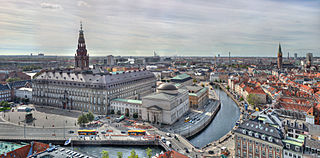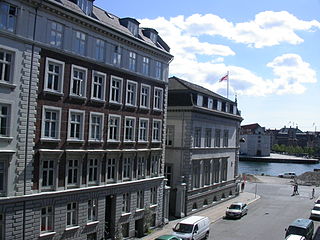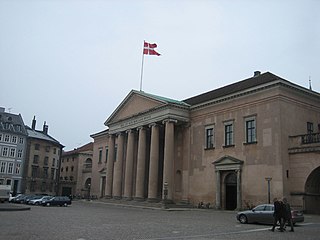
Copenhagen is the capital and most populous city of Denmark, with a population of 1.4 million in the urban area. The city is situated on the islands of Zealand and Amager, separated from Malmö, Sweden, by the Øresund strait. The Øresund Bridge connects the two cities by rail and road.

The history of Copenhagen dates back to the first settlement at the site in the 11th century. From the middle of the 12th century it grew in importance after coming into the possession of Bishop Absalon, and the city was fortified with a stone wall during the 13th century. The harbour and the excellent possibilities for herring fishing contributed to Copenhagen's growth and development into an important trading centre. It was repeatedly attacked by the Hanseatic League as the Germans became aware of its expansion. In 1254, it received its charter as a city under Bishop Jakob Erlandsen.

Christiansborg Palace is a palace and government building on the islet of Slotsholmen in central Copenhagen, Denmark. It is the seat of the Danish Parliament, the Danish Prime Minister's Office, and the Supreme Court of Denmark. Also, several parts of the palace are used by the Danish monarch, including the Royal Reception Rooms, the Palace Chapel and the Royal Stables.

Kastellet is a citadel located in Copenhagen, Denmark. It is one of the best preserved fortresses in Northern Europe. It is constructed in the form of a pentagon with bastions at its corners. Kastellet was continuous with the ring of bastioned ramparts which used to encircle Copenhagen but of which only the ramparts of Christianshavn remain today.

Slotsholmen is an island in the harbour of Copenhagen, Denmark, and part of Copenhagen Inner City. The name is taken from the successive castles and palaces located on the island since Bishop Absalon constructed the city's first castle on the island in 1167 at the site where Christiansborg Palace lies today.

Nyhavn is a 17th-century waterfront, canal and entertainment district in Copenhagen, Denmark. Stretching from Kongens Nytorv to the Inner Harbour just south of the Royal Playhouse, it is lined by brightly coloured 17th and early 18th century townhouses and bars, cafes and restaurants. The canal harbours many historical wooden ships.

Christian Frederik Hansen, known as C. F. Hansen, was the leading Danish architect between the late 18th century and the mid 19th century, and on account of his position at the Royal Danish Academy of Art the most powerful person in artistic circles for many years. He was known as "Denmark’s Palladio" on account of the architectural style he promoted. His buildings are known for their simplicity, strength and scale.

Caspar Frederik (Friedrich) Harsdorff, also known as C.F. Harsdorff, was a Danish neoclassical architect considered to have been the leading Danish architect in the late 18th century.

Copenhagen City Hall is the headquarters of the Copenhagen City Council as well as the Lord mayor of the Copenhagen Municipality, Denmark. The building is situated on City Hall Square in central Copenhagen.

Kongens Nytorv is a public square in Copenhagen, Denmark, centrally located at the end of the pedestrian street Strøget. The largest square of the city, it was laid out by Christian V in 1670 in connection with a major extension of the fortified city, and has an equestrian statue of him at its centre. The initiative moved the centre of the city from the medieval area around Gammeltorv, at that time a muddy medieval marketplace, to a cobbled new square with a garden complex, inspired by the Royal city planning seen in Paris from the early 17th century.

Gammelholm is a predominantly residential neighbourhood in the city centre of Copenhagen, Denmark. It is bounded by the Nyhavn canal, Kongens Nytorv, Holmens Kanal, Niels Juels Gade and the waterfront along Havnegade. For centuries, the area was the site of the Royal Naval Shipyard, known as Bremerholm, but after the naval activities relocated to Nyholm, it came under residential redevelopment in the 1860s and 1870s. The new neighbourhood was planned by Ferdinand Meldahl and has also been referred to as "Meldahl's Nine Streets". Apart from the buildings which face Kongens Nytorv, which include the Royal Danish Theatre and Charlottenborg Palace, the area is characterized by homogeneous Historicist architecture consisting of perimeter blocks with richly decorated house fronts.

Gammel Strand is a street and public square in central Copenhagen, Denmark. On the south side it borders on the narrow Slotsholmens Canal while the north side is lined by a row of brightly coloured houses from the 18th and 19th century. Across the canal, Thorvaldsens Museum and Christiansborg Palace are seen on the island Slotsholmen.

The Copenhagen Court House is a historic building located on Nytorv in Copenhagen, Denmark. Originally built as a combined city hall and courthouse, it now serves as the seat of the District Court of Copenhagen. Inaugurated in 1815, it was built to the design of Christian Frederik Hansen in Neoclassical style.

Den Danske Vitruvius is a richly illustrated 18th-century architectural work on Danish monumental buildings of the period, written by the Danish Baroque architect Lauritz de Thurah. It was commissioned by Christian VI in 1735 and published in two volumes between 1746 and 1749. The title refers to the Roman architect and engineer Vitruvius, who published De architectura in the 1st century AD, an authoritative treatise on the architecture of the time. The direct inspiration for de Thurah's Den Danske Vitruvius was Colen Campbell's Vitruvius Britannicus.

Amagertorv is a public square in the district of Indre By in central Copenhagen, Denmark. Today it forms part of the Strøget pedestrian zone, and is often described as the most central square in Copenhagen. Second only to Gammeltorv, it is also one of the oldest, taking its name from the Amager farmers who in the Middle Ages came into town to sell their produce at the site.

The Prince's Mansion is a palatial Rococo-style mansion located at Frederiksholms Kanal in central Copenhagen, Denmark. It used to serve as the official residence of the Crown Prince of Denmark but now houses the National Museum of Denmark.
This 1728 map of Copenhagen shows the overall layout of Copenhagen, Denmark, as well as the location of important buildings and other features, as it appeared Anno 1728, immediately before the Copenhagen Fire of 1728. The map shown here was published by Oluf Nielsen in 1884 but relies on a map published J. F. Arnoldt in January 1728. The original map can be seen here.

The Theatre Museum in the Court Theatre is situated at Christiansborg Palace on Slotsholmen, Copenhagen, Denmark, above the Royal Stables, and is on the first floor of the building. Its collection describes Danish theatre history from the 18th century to the present.
The following is a timeline of the history of the city of Saint Petersburg, Russia.

A/S Københavns Telefonkiosker, often referred to as KTK, was an operator of staffed telephone kiosks in Copenhagen, Denmark. The first telephone kiosks were installed in 1896 to an Art Nouveau-influenced National Romantic design by Fritz Koch. A new and somewhat larger model was introduced in 1913 but Koch's original design was again used when a number of new telephone kiosks were installed in 1929.



















